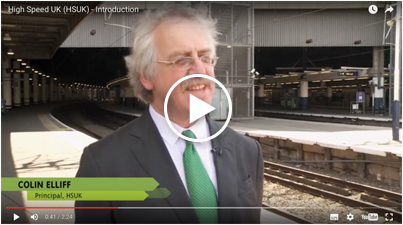










Question 1 for Boris Johnson and his transport advisors
How have you assessed and measured HS2’s success in delivering ‘hugely enhanced capacity and connectivity’ between the UK’s major conurbations?
This question matters because….
HS2 cannot be an end in itself. It only has value if it does deliver its self-
- ‘Levelling-
up’ the UK economy; - Achieving ‘Net Zero’ transport sector CO2 emissions;
- Strengthening transport links between the UK nations;
- ‘Building back better’ after the Covid-
19 pandemic.
The Government’s advisors in the Department for Transport should be constantly reviewing the design of HS2, and measuring its performance to check that it does indeed deliver its objective of ‘hugely enhanced capacity and connectivity’.
Regrettably, however, there is no indication that DfT, HS2 Ltd or any other responsible body have ever attempted to assess HS2’s performance as a network against the crucial goal of ‘hugely enhanced capacity and connectivity’. It would appear that they have simply assumed that the act of building HS2 must by default create this network.
Question 2 for Boris Johnson and his transport advisors
How have you determined that HS2 is the best means of achieving the objective of ‘hugely enhanced capacity and connectivity’?
This question matters because….
If Government is going to spend upwards of £100 billion of taxpayers’ money on its high speed rail project, it has an obvious obligation to every taxpayer to ensure that its chosen schemes i.e. HS2 and its subsidiary projects Northern Powerhouse Rail and Midlands Rail Hub, offer the best possible value for money. In other words, HS2 should achieve the greatest possible enhancements in capacity and connectivity for the least possible expenditure.
However, it is plain that HS2 cannot be this optimised scheme, delivering maximum ‘bangs for our bucks’. As we have demonstrated in our evidence presented to Boris Johnson, our HSUK scheme delivers over twice the connectivity in the Northern Powerhouse Region, and 5 times the connectivity in the Midlands. Moreover, HSUK achieves these benefits for significantly lower capital cost.
These facts have been repeatedly presented to the Government’s advisors. Regrettably, they have always chosen to ignore them.
Question 3 for Boris Johnson and his transport advisors
How have you designed HS2, Northern Powerhouse Rail and Midlands Rail Hub to integrate with the UK rail network, and thus achieve the best possible links between all of the UK’s major cities?
This question matters because….
It was always clear that HS2 on its own could not achieve its objective of ‘hugely enhanced capacity and connectivity’ between all of the UK’s major conurbations. It was always going to rely on additional interventions, in particular new transpennine links (Northern Powerhouse Rail) and major upgrades to the existing network.
But none of these projects could work in isolation, and there was always a clear necessity for all of these projects to be fully integrated with each other, and with the existing network, so that they could deliver the greatest possible performance as a network.
Regrettably, nothing of the sort appears ever to have happened. HS2 has been designed and developed in almost complete isolation from the existing rail network, and its routes have been selected along destructive rural corridors where integration with the existing network is impossible.
The folly of this approach is demonstrated by every aspect of HSUK’s vastly superior network performance in the Midlands, the North and Scotland.
Question 4 for Boris Johnson and his transport advisors
How have you developed the Integrated Rail Plan to remedy the disconnection between HS2, Northern Powerhouse Rail and Midlands Rail Hub and the existing railway system, and thus achieve the best possible network interlinking all UK communities?
This question matters because….
Successful implementation of the Integrated Rail Plan is crucial to the development of an improved and integrated national railway network delivering ‘hugely enhanced capacity and connectivity’, and this in turn is crucial to the Government’s ambitions for Levelling-
Yet the Integrated Rail Plan is wholly dependent upon constituent projects, in particular HS2, which were designed with no thought for integration.
This self-
Again, this deluded ‘thinking’ is exposed by the massively superior network performance of our HSUK Exemplar Alternative in both the Midlands and the North, and also in cross-
The simple moral of the story is that if you want an integrated network, it is advisable to design one from the start. It is not possible to retrofit integration.
Question 5 for Boris Johnson and his transport advisors
How have you determined that a national railway network based upon HS2, Northern Powerhouse Rail and Midlands Rail Hub will bring about the greatest possible road-
This question matters because….
The climate crisis matters – and it mattered even in 2009, when the HS2 project started. Every major Government project, and especially one of HS2’s magnitude, should have been remitted to play its full part in meeting official targets for radical reductions in CO2 emissions.
Yet even by the Government’s own account, HS2 will deliver virtually nothing. In the 2010 Command Paper that officially launched the project, HS2 was stated to be no better than carbon-
This failure is alarming, but it should not be surprising. The extraordinarily poor connectivity performance of any Integrated Rail Plan based on HS2 in the Midlands, the North or any UK region means that it will not bring about the transformational road-
All this is just another aspect of the design disaster that is HS2. With no requirement for integration or optimised network performance, it cannot deliver the integrated network necessary to meet the national – and indeed international – priority for Net Zero emissions.
It is of particular concern that no official figures of HS2’s CO2 emission profile have been published since 2010. The Government must publish updated figures to support its claims that HS2 will ‘play a vital role in delivering the Government’s carbon Net Zero objectives’.
Question 6 for Boris Johnson and his transport advisors
Where is your network connectivity analysis, to match that undertaken by HSUK?
This question matters because….
Optimised capacity and connectivity performance, and hence optimised Levelling-
It would be reasonable to expect a professional organisation such as HS2 Ltd, working to its self-
Yet there is no indication, in any of HS2 Ltd’s or the Government’s many reports, of any such structured process. It seems simply to have been assumed that the act of building HS2 will somehow bring about this optimised network.
Question 7 for Boris Johnson and his transport advisors
Please explain why the official proposals, variously HS2, Northern Powerhouse Rail and Midlands Rail Hub etc, perform so poorly on every conceivable criterion against the HSUK Exemplar Alternative.
This question matters because….
Any professional engaged in any design activity in which he or she claims to be an expert should be able to account for how their own proposals – in this case HS2, and subsidiary projects such as Northern Powerhouse Rail or Midlands Rail Hub – represent the best possible outcome, while alternative proposals – in this case HSUK – are for whatever reason inappropriate or unacceptable.
Yet none of the Government’s advisors – all supposedly experts in their chosen fields – have ever provided any cogent or coherent explanation for why HS2 works best in the public interest, and HSUK doesn’t. Instead, they have preferred to either to ignore HSUK, or worse, to misuse due process to prevent it from ever being considered.
This represents at the very least a comprehensive failure of professional conduct on the part of all concerned – and in view of the huge adverse consequences for the nation and for the environment, quite possibly criminal conduct also.








